Exploring Sociocultural Barriers to ESL Learning for Adult Immigrants
VerifiedAdded on 2022/08/26
|10
|2283
|18
Essay
AI Summary
This essay delves into the multifaceted barriers that adult immigrants encounter when learning English as a Second Language (ESL). It explores the impact of culture shock and language shock, highlighting how sudden shifts in socio-cultural environments can hinder the learning process. The essay further examines cultural stereotyping and its effects on ESL learners, including perceptions of linguistic abilities and educational backgrounds. It also discusses the influence of socio-political atmospheres and geographical factors, such as the availability of basic amenities and the structural differences between languages. Intrapersonal aspects, including motivation and the use of cognitive and socio-affective skills, are also analyzed. The essay concludes by emphasizing the importance of recognizing and addressing these barriers to facilitate effective ESL learning for immigrants and refugees alike.
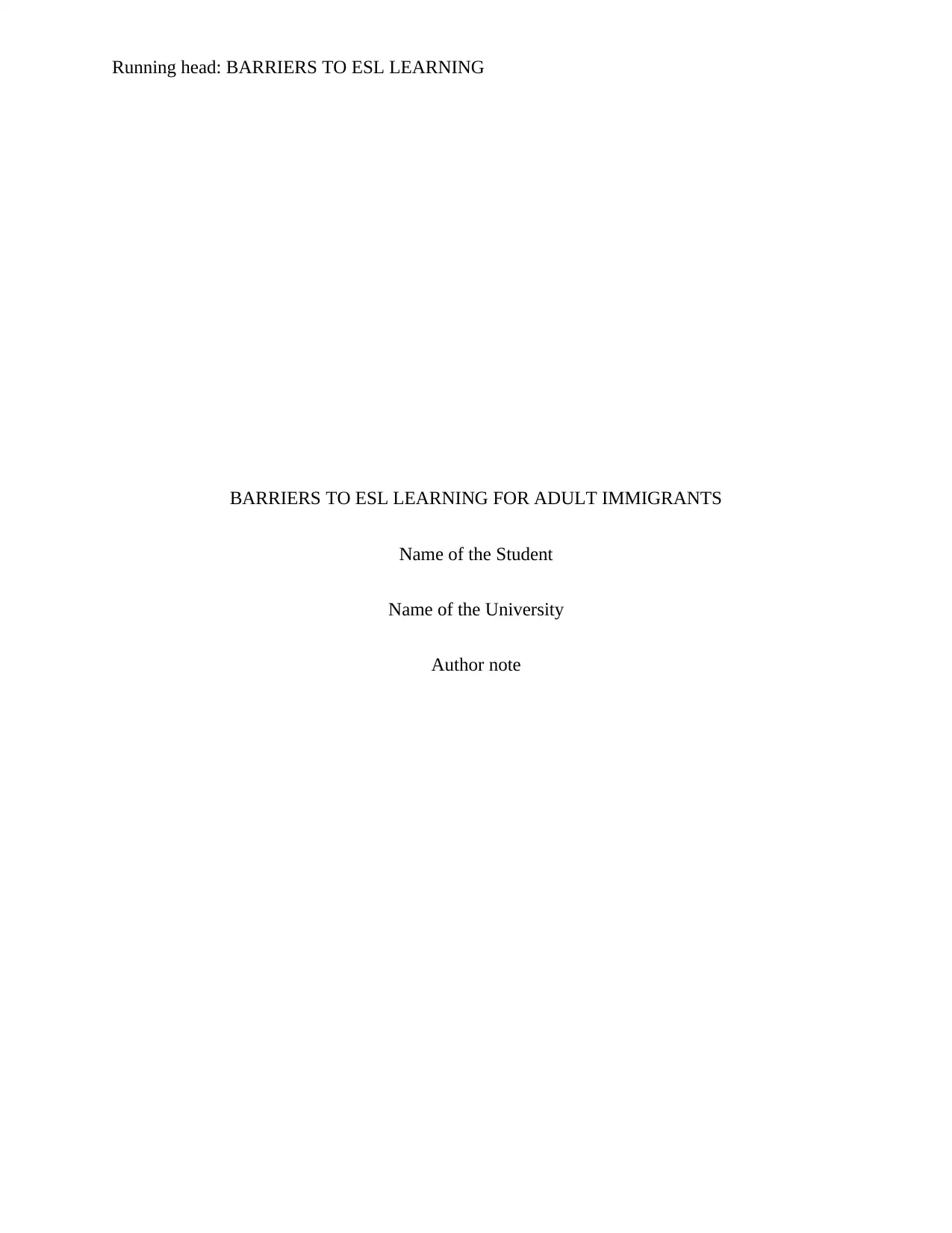
Running head: BARRIERS TO ESL LEARNING
BARRIERS TO ESL LEARNING FOR ADULT IMMIGRANTS
Name of the Student
Name of the University
Author note
BARRIERS TO ESL LEARNING FOR ADULT IMMIGRANTS
Name of the Student
Name of the University
Author note
Paraphrase This Document
Need a fresh take? Get an instant paraphrase of this document with our AI Paraphraser
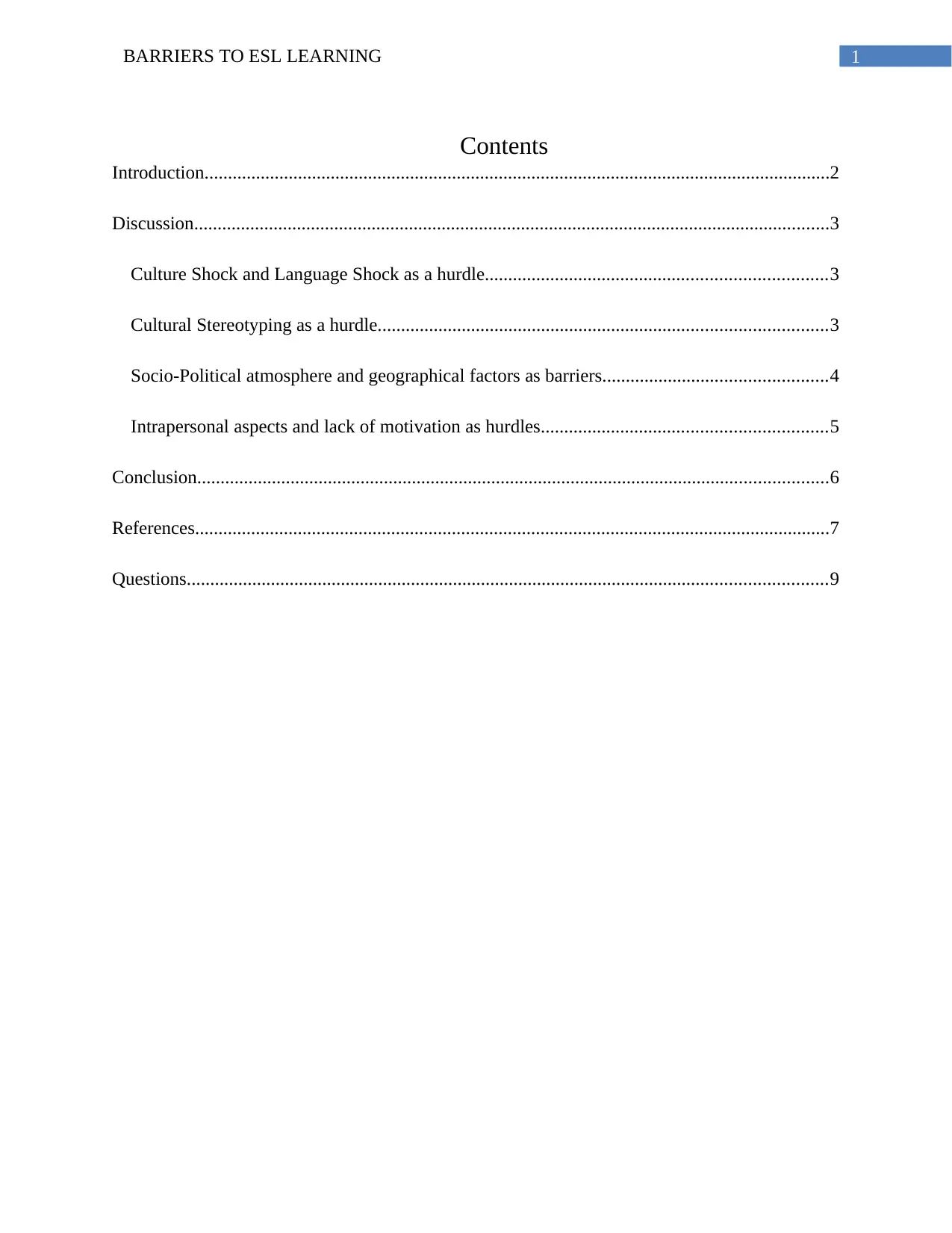
1BARRIERS TO ESL LEARNING
Contents
Introduction......................................................................................................................................2
Discussion........................................................................................................................................3
Culture Shock and Language Shock as a hurdle.........................................................................3
Cultural Stereotyping as a hurdle................................................................................................3
Socio-Political atmosphere and geographical factors as barriers................................................4
Intrapersonal aspects and lack of motivation as hurdles.............................................................5
Conclusion.......................................................................................................................................6
References........................................................................................................................................7
Questions.........................................................................................................................................9
Contents
Introduction......................................................................................................................................2
Discussion........................................................................................................................................3
Culture Shock and Language Shock as a hurdle.........................................................................3
Cultural Stereotyping as a hurdle................................................................................................3
Socio-Political atmosphere and geographical factors as barriers................................................4
Intrapersonal aspects and lack of motivation as hurdles.............................................................5
Conclusion.......................................................................................................................................6
References........................................................................................................................................7
Questions.........................................................................................................................................9
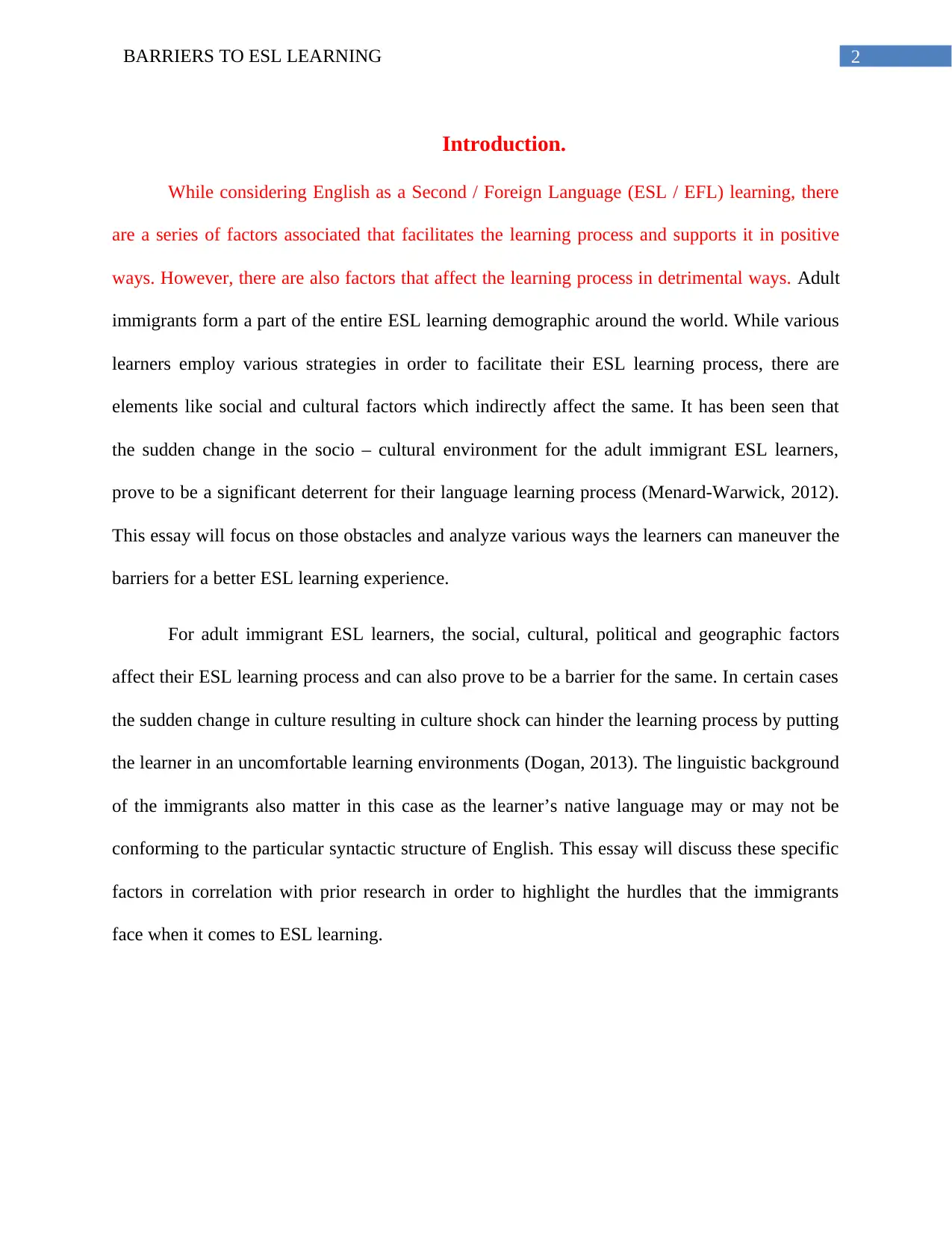
2BARRIERS TO ESL LEARNING
Introduction.
While considering English as a Second / Foreign Language (ESL / EFL) learning, there
are a series of factors associated that facilitates the learning process and supports it in positive
ways. However, there are also factors that affect the learning process in detrimental ways. Adult
immigrants form a part of the entire ESL learning demographic around the world. While various
learners employ various strategies in order to facilitate their ESL learning process, there are
elements like social and cultural factors which indirectly affect the same. It has been seen that
the sudden change in the socio – cultural environment for the adult immigrant ESL learners,
prove to be a significant deterrent for their language learning process (Menard-Warwick, 2012).
This essay will focus on those obstacles and analyze various ways the learners can maneuver the
barriers for a better ESL learning experience.
For adult immigrant ESL learners, the social, cultural, political and geographic factors
affect their ESL learning process and can also prove to be a barrier for the same. In certain cases
the sudden change in culture resulting in culture shock can hinder the learning process by putting
the learner in an uncomfortable learning environments (Dogan, 2013). The linguistic background
of the immigrants also matter in this case as the learner’s native language may or may not be
conforming to the particular syntactic structure of English. This essay will discuss these specific
factors in correlation with prior research in order to highlight the hurdles that the immigrants
face when it comes to ESL learning.
Introduction.
While considering English as a Second / Foreign Language (ESL / EFL) learning, there
are a series of factors associated that facilitates the learning process and supports it in positive
ways. However, there are also factors that affect the learning process in detrimental ways. Adult
immigrants form a part of the entire ESL learning demographic around the world. While various
learners employ various strategies in order to facilitate their ESL learning process, there are
elements like social and cultural factors which indirectly affect the same. It has been seen that
the sudden change in the socio – cultural environment for the adult immigrant ESL learners,
prove to be a significant deterrent for their language learning process (Menard-Warwick, 2012).
This essay will focus on those obstacles and analyze various ways the learners can maneuver the
barriers for a better ESL learning experience.
For adult immigrant ESL learners, the social, cultural, political and geographic factors
affect their ESL learning process and can also prove to be a barrier for the same. In certain cases
the sudden change in culture resulting in culture shock can hinder the learning process by putting
the learner in an uncomfortable learning environments (Dogan, 2013). The linguistic background
of the immigrants also matter in this case as the learner’s native language may or may not be
conforming to the particular syntactic structure of English. This essay will discuss these specific
factors in correlation with prior research in order to highlight the hurdles that the immigrants
face when it comes to ESL learning.
⊘ This is a preview!⊘
Do you want full access?
Subscribe today to unlock all pages.

Trusted by 1+ million students worldwide
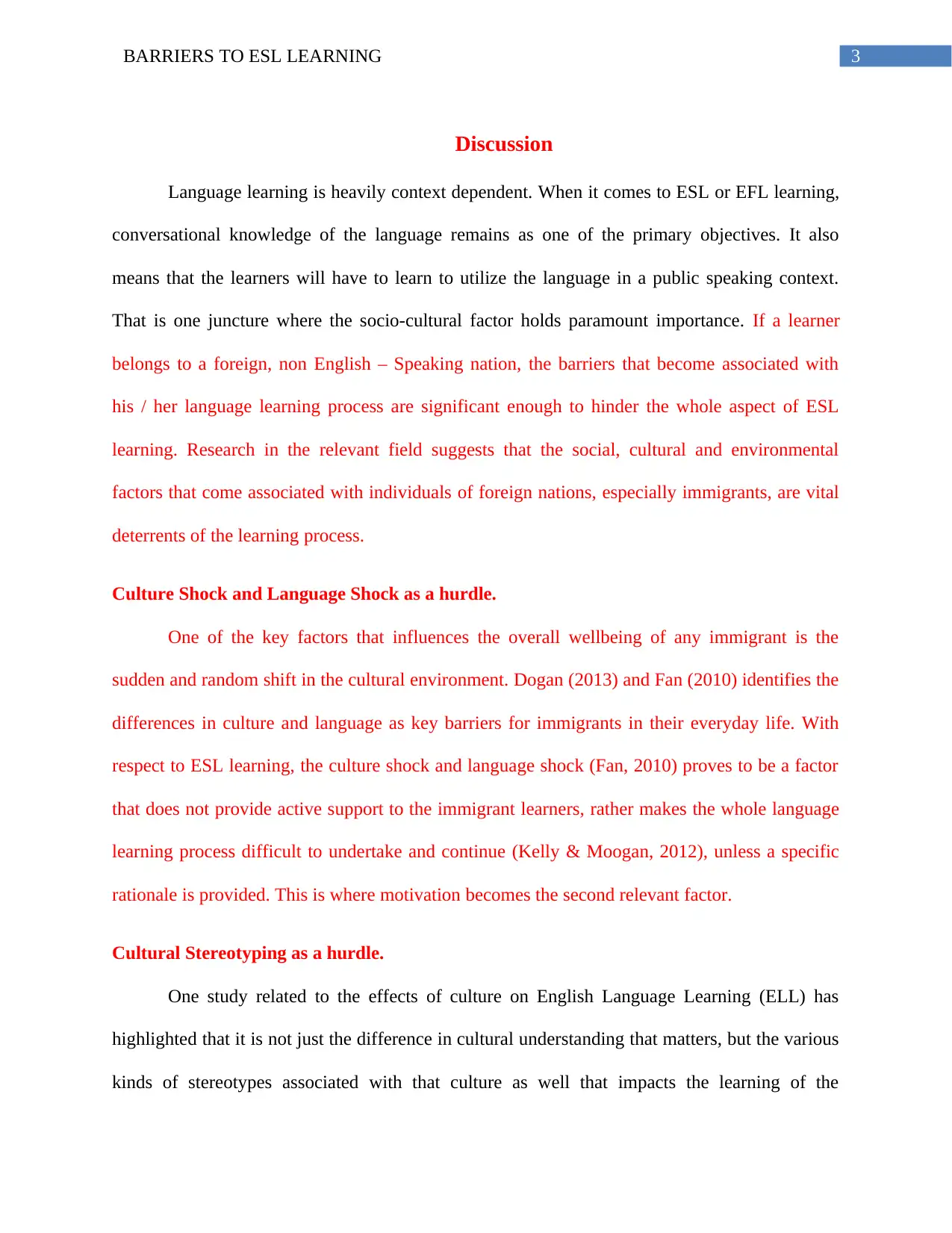
3BARRIERS TO ESL LEARNING
Discussion
Language learning is heavily context dependent. When it comes to ESL or EFL learning,
conversational knowledge of the language remains as one of the primary objectives. It also
means that the learners will have to learn to utilize the language in a public speaking context.
That is one juncture where the socio-cultural factor holds paramount importance. If a learner
belongs to a foreign, non English – Speaking nation, the barriers that become associated with
his / her language learning process are significant enough to hinder the whole aspect of ESL
learning. Research in the relevant field suggests that the social, cultural and environmental
factors that come associated with individuals of foreign nations, especially immigrants, are vital
deterrents of the learning process.
Culture Shock and Language Shock as a hurdle.
One of the key factors that influences the overall wellbeing of any immigrant is the
sudden and random shift in the cultural environment. Dogan (2013) and Fan (2010) identifies the
differences in culture and language as key barriers for immigrants in their everyday life. With
respect to ESL learning, the culture shock and language shock (Fan, 2010) proves to be a factor
that does not provide active support to the immigrant learners, rather makes the whole language
learning process difficult to undertake and continue (Kelly & Moogan, 2012), unless a specific
rationale is provided. This is where motivation becomes the second relevant factor.
Cultural Stereotyping as a hurdle.
One study related to the effects of culture on English Language Learning (ELL) has
highlighted that it is not just the difference in cultural understanding that matters, but the various
kinds of stereotypes associated with that culture as well that impacts the learning of the
Discussion
Language learning is heavily context dependent. When it comes to ESL or EFL learning,
conversational knowledge of the language remains as one of the primary objectives. It also
means that the learners will have to learn to utilize the language in a public speaking context.
That is one juncture where the socio-cultural factor holds paramount importance. If a learner
belongs to a foreign, non English – Speaking nation, the barriers that become associated with
his / her language learning process are significant enough to hinder the whole aspect of ESL
learning. Research in the relevant field suggests that the social, cultural and environmental
factors that come associated with individuals of foreign nations, especially immigrants, are vital
deterrents of the learning process.
Culture Shock and Language Shock as a hurdle.
One of the key factors that influences the overall wellbeing of any immigrant is the
sudden and random shift in the cultural environment. Dogan (2013) and Fan (2010) identifies the
differences in culture and language as key barriers for immigrants in their everyday life. With
respect to ESL learning, the culture shock and language shock (Fan, 2010) proves to be a factor
that does not provide active support to the immigrant learners, rather makes the whole language
learning process difficult to undertake and continue (Kelly & Moogan, 2012), unless a specific
rationale is provided. This is where motivation becomes the second relevant factor.
Cultural Stereotyping as a hurdle.
One study related to the effects of culture on English Language Learning (ELL) has
highlighted that it is not just the difference in cultural understanding that matters, but the various
kinds of stereotypes associated with that culture as well that impacts the learning of the
Paraphrase This Document
Need a fresh take? Get an instant paraphrase of this document with our AI Paraphraser
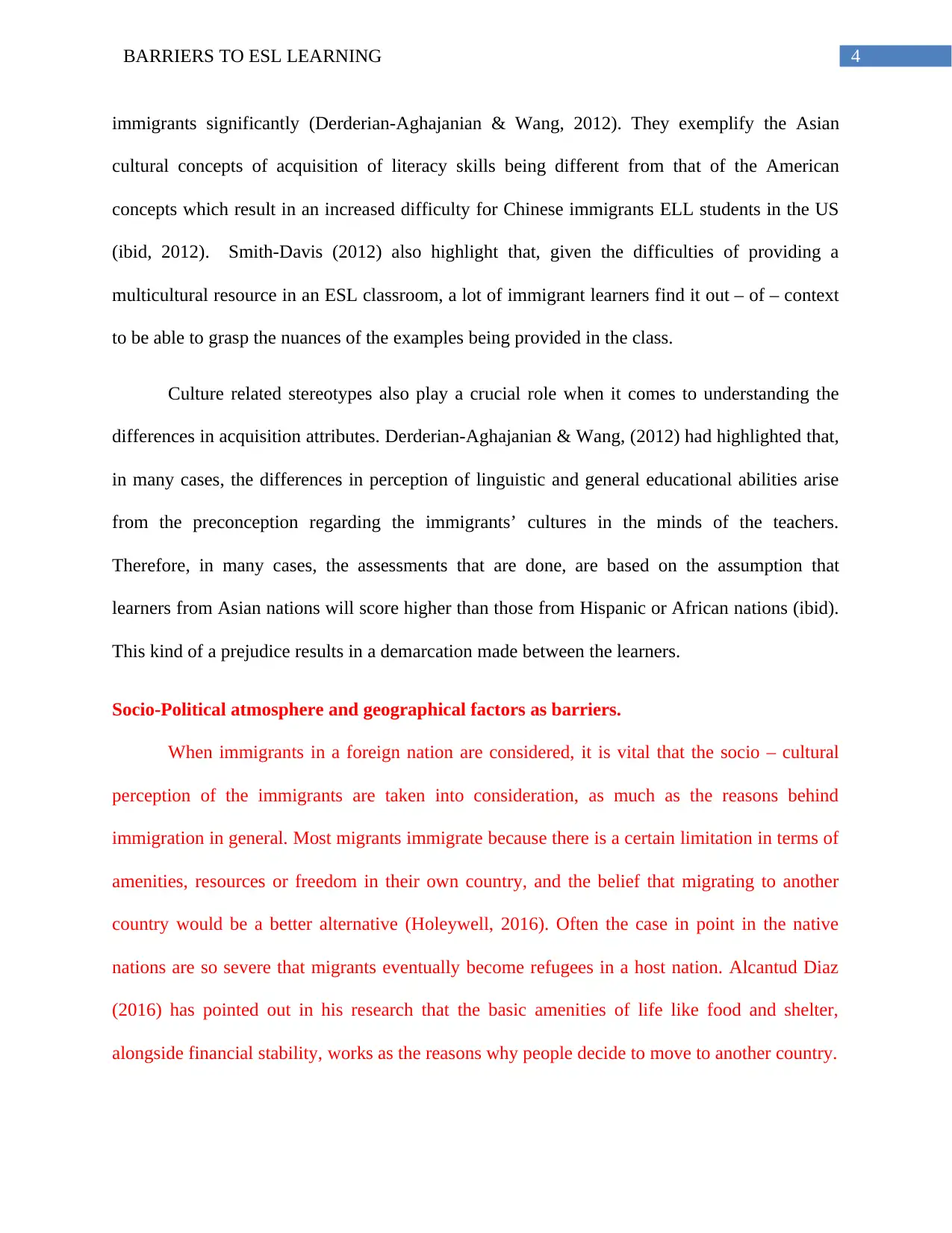
4BARRIERS TO ESL LEARNING
immigrants significantly (Derderian-Aghajanian & Wang, 2012). They exemplify the Asian
cultural concepts of acquisition of literacy skills being different from that of the American
concepts which result in an increased difficulty for Chinese immigrants ELL students in the US
(ibid, 2012). Smith-Davis (2012) also highlight that, given the difficulties of providing a
multicultural resource in an ESL classroom, a lot of immigrant learners find it out – of – context
to be able to grasp the nuances of the examples being provided in the class.
Culture related stereotypes also play a crucial role when it comes to understanding the
differences in acquisition attributes. Derderian-Aghajanian & Wang, (2012) had highlighted that,
in many cases, the differences in perception of linguistic and general educational abilities arise
from the preconception regarding the immigrants’ cultures in the minds of the teachers.
Therefore, in many cases, the assessments that are done, are based on the assumption that
learners from Asian nations will score higher than those from Hispanic or African nations (ibid).
This kind of a prejudice results in a demarcation made between the learners.
Socio-Political atmosphere and geographical factors as barriers.
When immigrants in a foreign nation are considered, it is vital that the socio – cultural
perception of the immigrants are taken into consideration, as much as the reasons behind
immigration in general. Most migrants immigrate because there is a certain limitation in terms of
amenities, resources or freedom in their own country, and the belief that migrating to another
country would be a better alternative (Holeywell, 2016). Often the case in point in the native
nations are so severe that migrants eventually become refugees in a host nation. Alcantud Diaz
(2016) has pointed out in his research that the basic amenities of life like food and shelter,
alongside financial stability, works as the reasons why people decide to move to another country.
immigrants significantly (Derderian-Aghajanian & Wang, 2012). They exemplify the Asian
cultural concepts of acquisition of literacy skills being different from that of the American
concepts which result in an increased difficulty for Chinese immigrants ELL students in the US
(ibid, 2012). Smith-Davis (2012) also highlight that, given the difficulties of providing a
multicultural resource in an ESL classroom, a lot of immigrant learners find it out – of – context
to be able to grasp the nuances of the examples being provided in the class.
Culture related stereotypes also play a crucial role when it comes to understanding the
differences in acquisition attributes. Derderian-Aghajanian & Wang, (2012) had highlighted that,
in many cases, the differences in perception of linguistic and general educational abilities arise
from the preconception regarding the immigrants’ cultures in the minds of the teachers.
Therefore, in many cases, the assessments that are done, are based on the assumption that
learners from Asian nations will score higher than those from Hispanic or African nations (ibid).
This kind of a prejudice results in a demarcation made between the learners.
Socio-Political atmosphere and geographical factors as barriers.
When immigrants in a foreign nation are considered, it is vital that the socio – cultural
perception of the immigrants are taken into consideration, as much as the reasons behind
immigration in general. Most migrants immigrate because there is a certain limitation in terms of
amenities, resources or freedom in their own country, and the belief that migrating to another
country would be a better alternative (Holeywell, 2016). Often the case in point in the native
nations are so severe that migrants eventually become refugees in a host nation. Alcantud Diaz
(2016) has pointed out in his research that the basic amenities of life like food and shelter,
alongside financial stability, works as the reasons why people decide to move to another country.
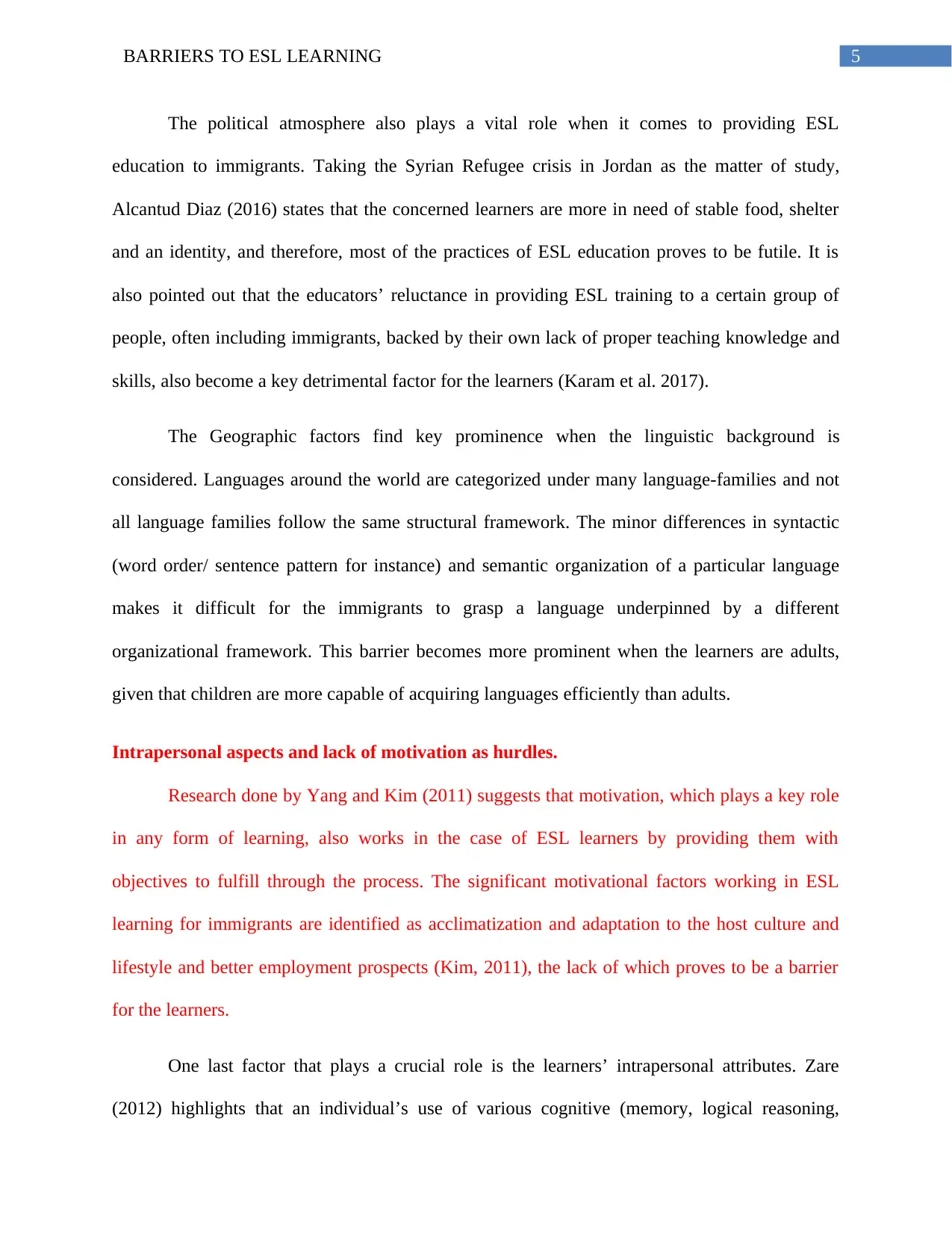
5BARRIERS TO ESL LEARNING
The political atmosphere also plays a vital role when it comes to providing ESL
education to immigrants. Taking the Syrian Refugee crisis in Jordan as the matter of study,
Alcantud Diaz (2016) states that the concerned learners are more in need of stable food, shelter
and an identity, and therefore, most of the practices of ESL education proves to be futile. It is
also pointed out that the educators’ reluctance in providing ESL training to a certain group of
people, often including immigrants, backed by their own lack of proper teaching knowledge and
skills, also become a key detrimental factor for the learners (Karam et al. 2017).
The Geographic factors find key prominence when the linguistic background is
considered. Languages around the world are categorized under many language-families and not
all language families follow the same structural framework. The minor differences in syntactic
(word order/ sentence pattern for instance) and semantic organization of a particular language
makes it difficult for the immigrants to grasp a language underpinned by a different
organizational framework. This barrier becomes more prominent when the learners are adults,
given that children are more capable of acquiring languages efficiently than adults.
Intrapersonal aspects and lack of motivation as hurdles.
Research done by Yang and Kim (2011) suggests that motivation, which plays a key role
in any form of learning, also works in the case of ESL learners by providing them with
objectives to fulfill through the process. The significant motivational factors working in ESL
learning for immigrants are identified as acclimatization and adaptation to the host culture and
lifestyle and better employment prospects (Kim, 2011), the lack of which proves to be a barrier
for the learners.
One last factor that plays a crucial role is the learners’ intrapersonal attributes. Zare
(2012) highlights that an individual’s use of various cognitive (memory, logical reasoning,
The political atmosphere also plays a vital role when it comes to providing ESL
education to immigrants. Taking the Syrian Refugee crisis in Jordan as the matter of study,
Alcantud Diaz (2016) states that the concerned learners are more in need of stable food, shelter
and an identity, and therefore, most of the practices of ESL education proves to be futile. It is
also pointed out that the educators’ reluctance in providing ESL training to a certain group of
people, often including immigrants, backed by their own lack of proper teaching knowledge and
skills, also become a key detrimental factor for the learners (Karam et al. 2017).
The Geographic factors find key prominence when the linguistic background is
considered. Languages around the world are categorized under many language-families and not
all language families follow the same structural framework. The minor differences in syntactic
(word order/ sentence pattern for instance) and semantic organization of a particular language
makes it difficult for the immigrants to grasp a language underpinned by a different
organizational framework. This barrier becomes more prominent when the learners are adults,
given that children are more capable of acquiring languages efficiently than adults.
Intrapersonal aspects and lack of motivation as hurdles.
Research done by Yang and Kim (2011) suggests that motivation, which plays a key role
in any form of learning, also works in the case of ESL learners by providing them with
objectives to fulfill through the process. The significant motivational factors working in ESL
learning for immigrants are identified as acclimatization and adaptation to the host culture and
lifestyle and better employment prospects (Kim, 2011), the lack of which proves to be a barrier
for the learners.
One last factor that plays a crucial role is the learners’ intrapersonal attributes. Zare
(2012) highlights that an individual’s use of various cognitive (memory, logical reasoning,
⊘ This is a preview!⊘
Do you want full access?
Subscribe today to unlock all pages.

Trusted by 1+ million students worldwide
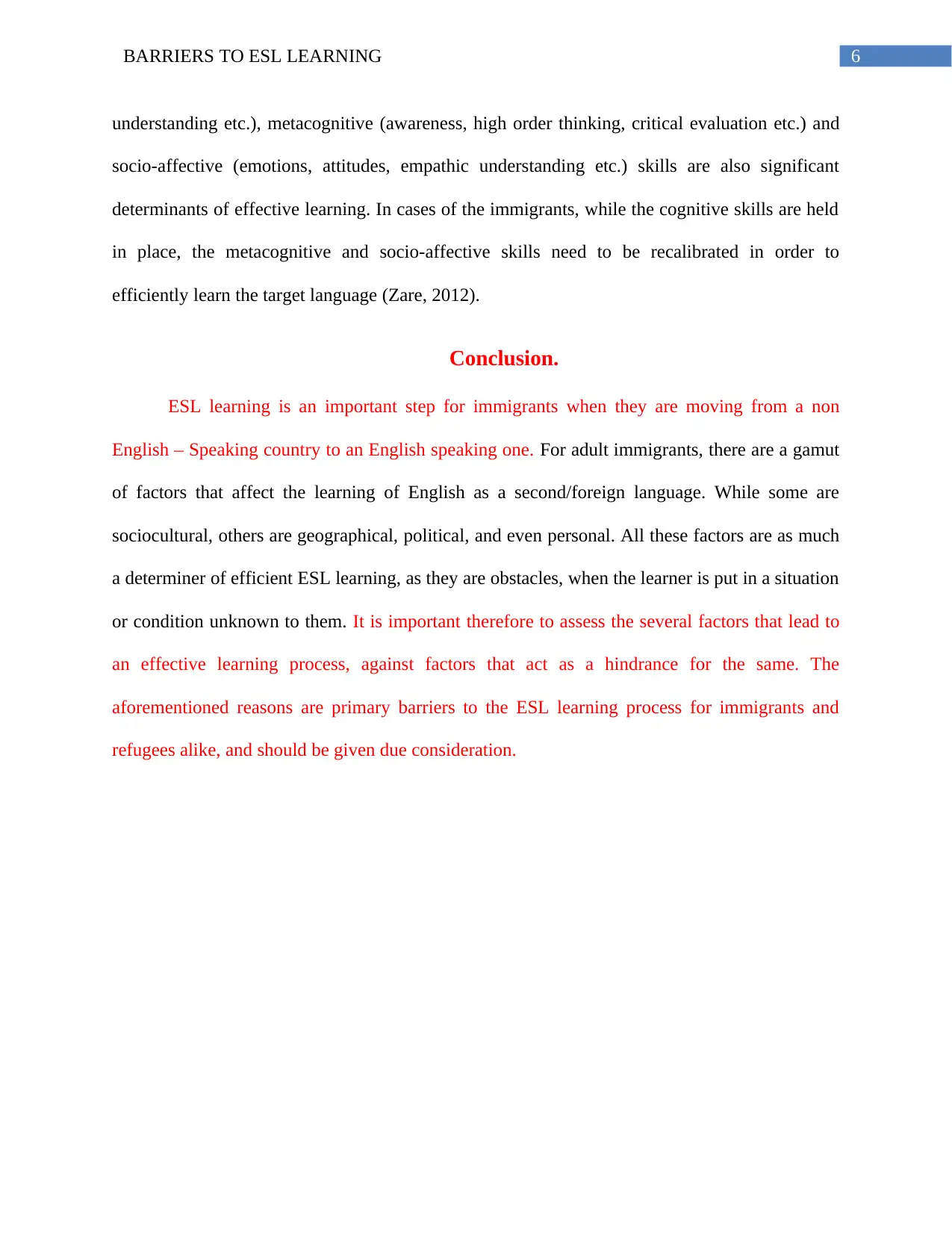
6BARRIERS TO ESL LEARNING
understanding etc.), metacognitive (awareness, high order thinking, critical evaluation etc.) and
socio-affective (emotions, attitudes, empathic understanding etc.) skills are also significant
determinants of effective learning. In cases of the immigrants, while the cognitive skills are held
in place, the metacognitive and socio-affective skills need to be recalibrated in order to
efficiently learn the target language (Zare, 2012).
Conclusion.
ESL learning is an important step for immigrants when they are moving from a non
English – Speaking country to an English speaking one. For adult immigrants, there are a gamut
of factors that affect the learning of English as a second/foreign language. While some are
sociocultural, others are geographical, political, and even personal. All these factors are as much
a determiner of efficient ESL learning, as they are obstacles, when the learner is put in a situation
or condition unknown to them. It is important therefore to assess the several factors that lead to
an effective learning process, against factors that act as a hindrance for the same. The
aforementioned reasons are primary barriers to the ESL learning process for immigrants and
refugees alike, and should be given due consideration.
understanding etc.), metacognitive (awareness, high order thinking, critical evaluation etc.) and
socio-affective (emotions, attitudes, empathic understanding etc.) skills are also significant
determinants of effective learning. In cases of the immigrants, while the cognitive skills are held
in place, the metacognitive and socio-affective skills need to be recalibrated in order to
efficiently learn the target language (Zare, 2012).
Conclusion.
ESL learning is an important step for immigrants when they are moving from a non
English – Speaking country to an English speaking one. For adult immigrants, there are a gamut
of factors that affect the learning of English as a second/foreign language. While some are
sociocultural, others are geographical, political, and even personal. All these factors are as much
a determiner of efficient ESL learning, as they are obstacles, when the learner is put in a situation
or condition unknown to them. It is important therefore to assess the several factors that lead to
an effective learning process, against factors that act as a hindrance for the same. The
aforementioned reasons are primary barriers to the ESL learning process for immigrants and
refugees alike, and should be given due consideration.
Paraphrase This Document
Need a fresh take? Get an instant paraphrase of this document with our AI Paraphraser
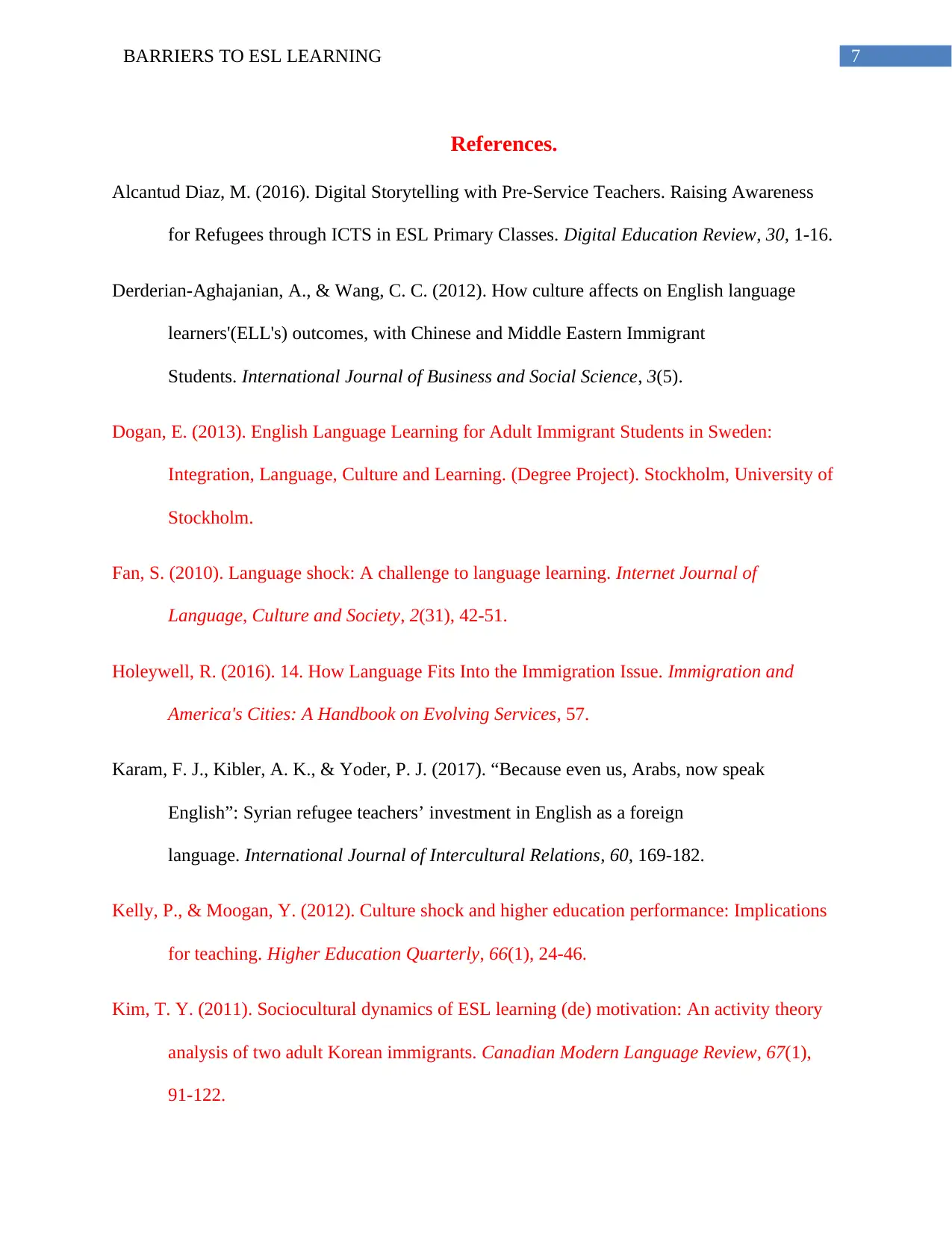
7BARRIERS TO ESL LEARNING
References.
Alcantud Diaz, M. (2016). Digital Storytelling with Pre-Service Teachers. Raising Awareness
for Refugees through ICTS in ESL Primary Classes. Digital Education Review, 30, 1-16.
Derderian-Aghajanian, A., & Wang, C. C. (2012). How culture affects on English language
learners'(ELL's) outcomes, with Chinese and Middle Eastern Immigrant
Students. International Journal of Business and Social Science, 3(5).
Dogan, E. (2013). English Language Learning for Adult Immigrant Students in Sweden:
Integration, Language, Culture and Learning. (Degree Project). Stockholm, University of
Stockholm.
Fan, S. (2010). Language shock: A challenge to language learning. Internet Journal of
Language, Culture and Society, 2(31), 42-51.
Holeywell, R. (2016). 14. How Language Fits Into the Immigration Issue. Immigration and
America's Cities: A Handbook on Evolving Services, 57.
Karam, F. J., Kibler, A. K., & Yoder, P. J. (2017). “Because even us, Arabs, now speak
English”: Syrian refugee teachers’ investment in English as a foreign
language. International Journal of Intercultural Relations, 60, 169-182.
Kelly, P., & Moogan, Y. (2012). Culture shock and higher education performance: Implications
for teaching. Higher Education Quarterly, 66(1), 24-46.
Kim, T. Y. (2011). Sociocultural dynamics of ESL learning (de) motivation: An activity theory
analysis of two adult Korean immigrants. Canadian Modern Language Review, 67(1),
91-122.
References.
Alcantud Diaz, M. (2016). Digital Storytelling with Pre-Service Teachers. Raising Awareness
for Refugees through ICTS in ESL Primary Classes. Digital Education Review, 30, 1-16.
Derderian-Aghajanian, A., & Wang, C. C. (2012). How culture affects on English language
learners'(ELL's) outcomes, with Chinese and Middle Eastern Immigrant
Students. International Journal of Business and Social Science, 3(5).
Dogan, E. (2013). English Language Learning for Adult Immigrant Students in Sweden:
Integration, Language, Culture and Learning. (Degree Project). Stockholm, University of
Stockholm.
Fan, S. (2010). Language shock: A challenge to language learning. Internet Journal of
Language, Culture and Society, 2(31), 42-51.
Holeywell, R. (2016). 14. How Language Fits Into the Immigration Issue. Immigration and
America's Cities: A Handbook on Evolving Services, 57.
Karam, F. J., Kibler, A. K., & Yoder, P. J. (2017). “Because even us, Arabs, now speak
English”: Syrian refugee teachers’ investment in English as a foreign
language. International Journal of Intercultural Relations, 60, 169-182.
Kelly, P., & Moogan, Y. (2012). Culture shock and higher education performance: Implications
for teaching. Higher Education Quarterly, 66(1), 24-46.
Kim, T. Y. (2011). Sociocultural dynamics of ESL learning (de) motivation: An activity theory
analysis of two adult Korean immigrants. Canadian Modern Language Review, 67(1),
91-122.
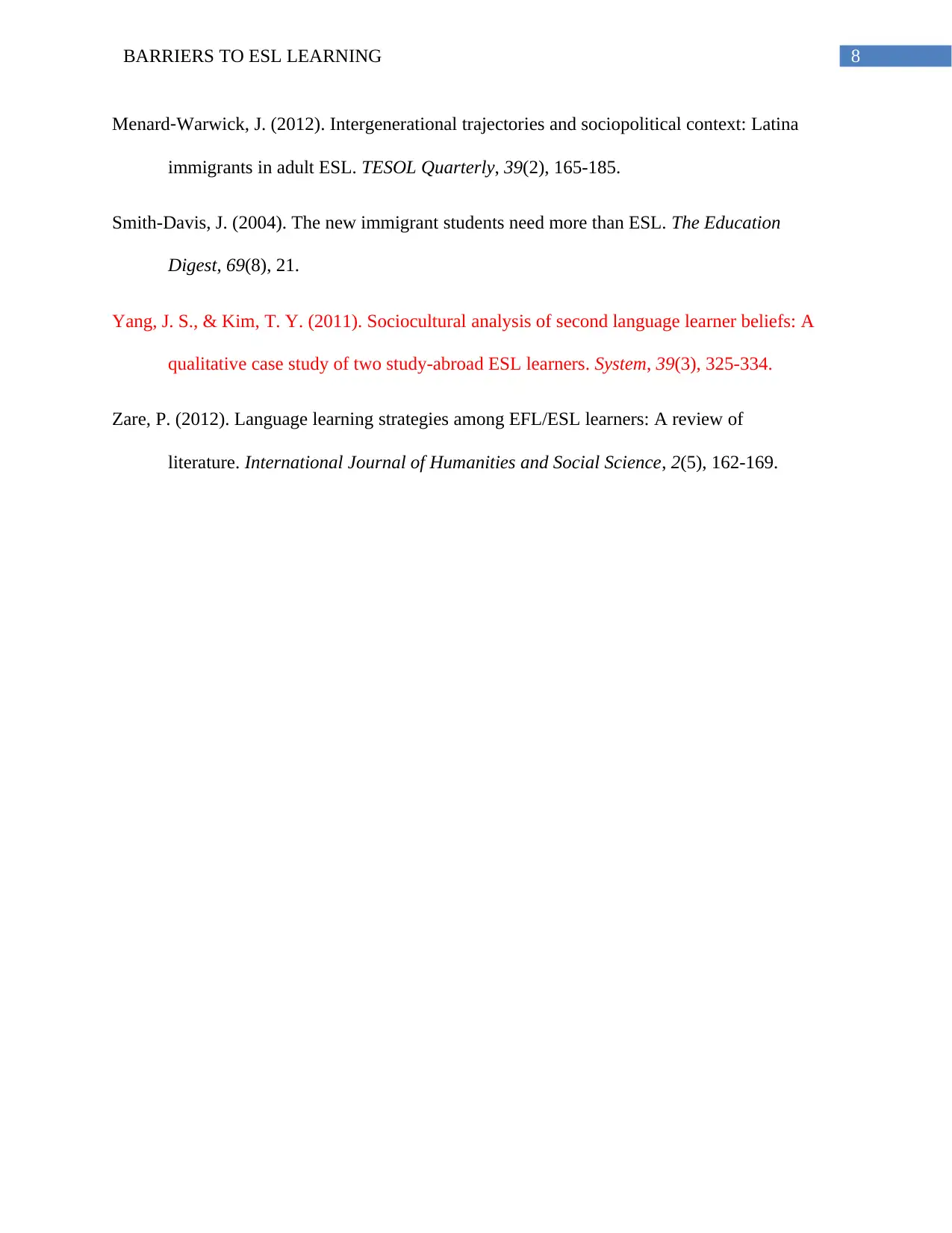
8BARRIERS TO ESL LEARNING
Menard‐Warwick, J. (2012). Intergenerational trajectories and sociopolitical context: Latina
immigrants in adult ESL. TESOL Quarterly, 39(2), 165-185.
Smith-Davis, J. (2004). The new immigrant students need more than ESL. The Education
Digest, 69(8), 21.
Yang, J. S., & Kim, T. Y. (2011). Sociocultural analysis of second language learner beliefs: A
qualitative case study of two study-abroad ESL learners. System, 39(3), 325-334.
Zare, P. (2012). Language learning strategies among EFL/ESL learners: A review of
literature. International Journal of Humanities and Social Science, 2(5), 162-169.
Menard‐Warwick, J. (2012). Intergenerational trajectories and sociopolitical context: Latina
immigrants in adult ESL. TESOL Quarterly, 39(2), 165-185.
Smith-Davis, J. (2004). The new immigrant students need more than ESL. The Education
Digest, 69(8), 21.
Yang, J. S., & Kim, T. Y. (2011). Sociocultural analysis of second language learner beliefs: A
qualitative case study of two study-abroad ESL learners. System, 39(3), 325-334.
Zare, P. (2012). Language learning strategies among EFL/ESL learners: A review of
literature. International Journal of Humanities and Social Science, 2(5), 162-169.
⊘ This is a preview!⊘
Do you want full access?
Subscribe today to unlock all pages.

Trusted by 1+ million students worldwide
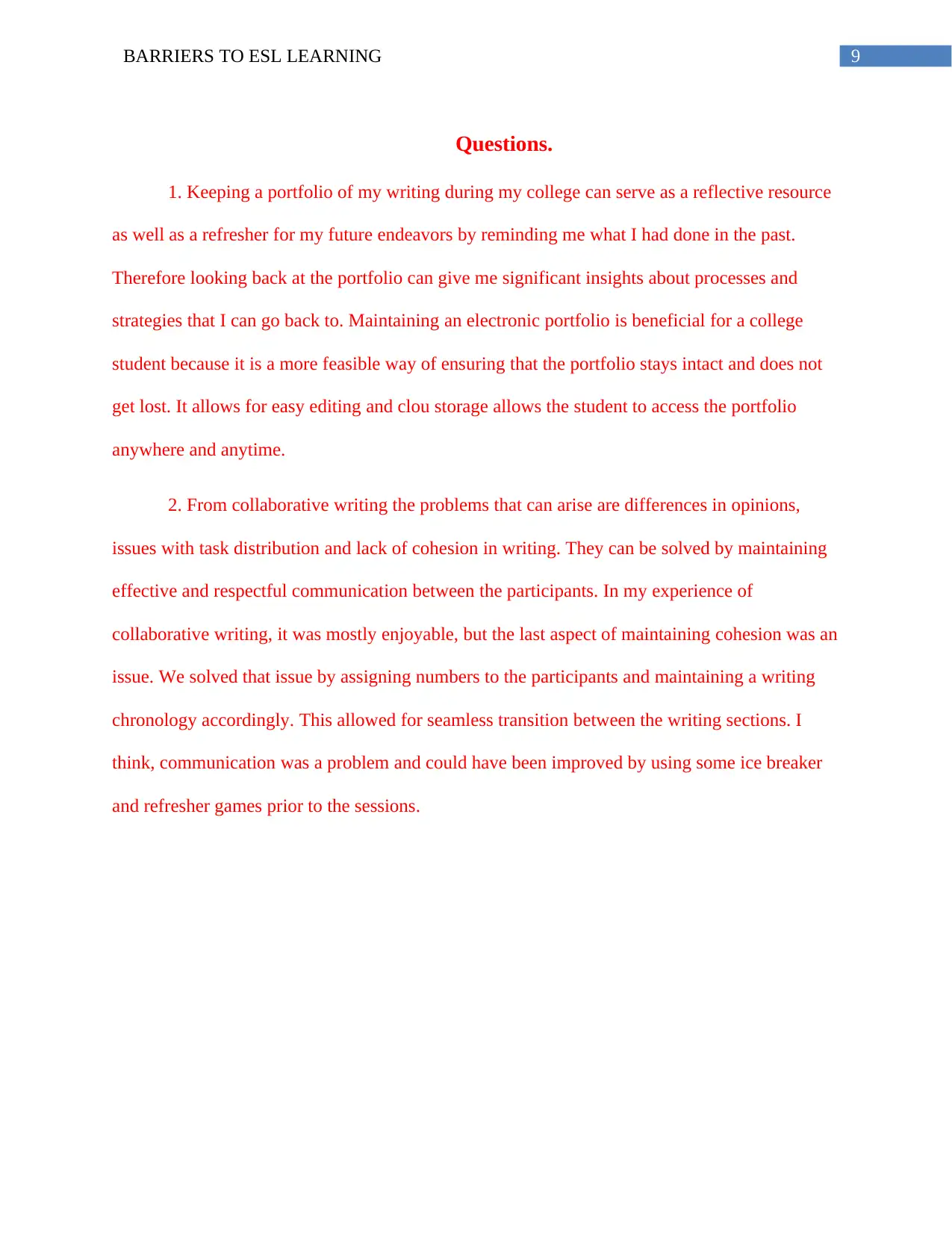
9BARRIERS TO ESL LEARNING
Questions.
1. Keeping a portfolio of my writing during my college can serve as a reflective resource
as well as a refresher for my future endeavors by reminding me what I had done in the past.
Therefore looking back at the portfolio can give me significant insights about processes and
strategies that I can go back to. Maintaining an electronic portfolio is beneficial for a college
student because it is a more feasible way of ensuring that the portfolio stays intact and does not
get lost. It allows for easy editing and clou storage allows the student to access the portfolio
anywhere and anytime.
2. From collaborative writing the problems that can arise are differences in opinions,
issues with task distribution and lack of cohesion in writing. They can be solved by maintaining
effective and respectful communication between the participants. In my experience of
collaborative writing, it was mostly enjoyable, but the last aspect of maintaining cohesion was an
issue. We solved that issue by assigning numbers to the participants and maintaining a writing
chronology accordingly. This allowed for seamless transition between the writing sections. I
think, communication was a problem and could have been improved by using some ice breaker
and refresher games prior to the sessions.
Questions.
1. Keeping a portfolio of my writing during my college can serve as a reflective resource
as well as a refresher for my future endeavors by reminding me what I had done in the past.
Therefore looking back at the portfolio can give me significant insights about processes and
strategies that I can go back to. Maintaining an electronic portfolio is beneficial for a college
student because it is a more feasible way of ensuring that the portfolio stays intact and does not
get lost. It allows for easy editing and clou storage allows the student to access the portfolio
anywhere and anytime.
2. From collaborative writing the problems that can arise are differences in opinions,
issues with task distribution and lack of cohesion in writing. They can be solved by maintaining
effective and respectful communication between the participants. In my experience of
collaborative writing, it was mostly enjoyable, but the last aspect of maintaining cohesion was an
issue. We solved that issue by assigning numbers to the participants and maintaining a writing
chronology accordingly. This allowed for seamless transition between the writing sections. I
think, communication was a problem and could have been improved by using some ice breaker
and refresher games prior to the sessions.
1 out of 10
Your All-in-One AI-Powered Toolkit for Academic Success.
+13062052269
info@desklib.com
Available 24*7 on WhatsApp / Email
![[object Object]](/_next/static/media/star-bottom.7253800d.svg)
Unlock your academic potential
Copyright © 2020–2025 A2Z Services. All Rights Reserved. Developed and managed by ZUCOL.


